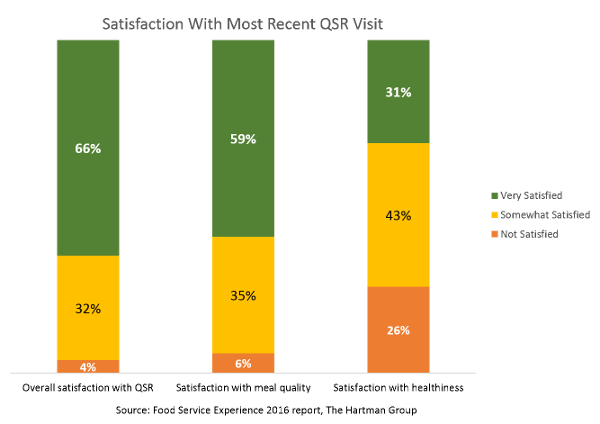What’s Up With the QSR Sales Slump?
 When Americans feel good about things, we tend to celebrate by eating out. We gather loved ones, family or friends and head to our favorite restaurant and revel in the special occasion. But America’s diners are not in much of a celebratory mood these days, at least that’s what CEOs of some of the largest quick service restaurants (QSR) brands would have us believe. These leaders attribute the recent QSR sector sales slowdown to an unsettling reluctance among diners to eat out due to distractions from economic uncertainty, poor weather in parts of the country, contentious presidential election, and even civil unrest, domestic terrorism or the past summer Olympics.
When Americans feel good about things, we tend to celebrate by eating out. We gather loved ones, family or friends and head to our favorite restaurant and revel in the special occasion. But America’s diners are not in much of a celebratory mood these days, at least that’s what CEOs of some of the largest quick service restaurants (QSR) brands would have us believe. These leaders attribute the recent QSR sector sales slowdown to an unsettling reluctance among diners to eat out due to distractions from economic uncertainty, poor weather in parts of the country, contentious presidential election, and even civil unrest, domestic terrorism or the past summer Olympics.
It was once true that eating out was a special occasion, but that’s largely changed now to the point where eating out (or ordering off the menu) is now an everyday occasion.
The truth today (and at risk of puncturing the plot of QSR's lament) underlying some of the QSR slowdown may boil down to consumers growing increasingly astute about what, when and where they want to eat, and the vast array of choices that rise up to meet those needs today.
The Hartman Group’s Food Service Experience 2016 report finds that what consumers want when they make the decision to order off of menus is starting to bear close resemblance to the same revolution they have been driving within food retail and in their home kitchens for some time now, namely meals that are fresher, higher quality, and with overall healthful distinctions that can be customized for increasingly discerning palates. That said, it's important to remember that not all eating out decisions are driven by desires for freshness, quality and health. Convenience (e.g., drive-through, food portability), indulgence, atmosphere and value remain very important aspects in consumers’ decisions.
Expectations of the QSR Channel
Quick serve restaurants hold a uniquely iconic place in American food culture that is not easily substitutable. The car and the fast food drive-thru have historically worked hand in hand as icons of American identity and food sourcing. Consequently, the cultural expectations that Americans have towards QSR as a channel are deeply ingrained to the point that they are largely habitual and assumed.
- While we hesitate to call such expectations “lower” (than at other channels), there is a prevailing attitude among consumers that “fast food is what it is”
- And yet, consumers tend to hold a working hierarchy of “better” food establishments, often justifying their chosen restaurant to another by telling themselves, “at least it’s not [INSERT FAST FOOD CHAIN NAME HERE]”
Consumers typically know what to expect when visiting a fast food restaurant and are seldom disappointed. About two-thirds of consumers (66 percent) said they were “very satisfied” with their most recent QSR visit and more than half (59 percent) said they were “very satisfied” with quality of the meal.
While overall satisfaction with QSR is fairly high, there is room for improvement, particularly in the area of healthiness. Since restaurant usage tends to be for occasions such as a “break from routine/cooking” or when “out and about” (and being at home is not practical), many consumers give themselves a “pass” on healthy choices when getting a restaurant meal or snack. Compared to at home, 6 in 10 consumers say they eat “less healthy” when eating out at QSR.
Fast food has suffered the stigma as a channel that serves unhealthy, processed, cheaper and poorer-quality food.
- Chains that disrupt these entrenched consumer expectations by bringing an emphasis on freshness, customization, service, atmosphere, efficiency and health are shifting the QSR paradigm
- The primary challenge in QSR is keeping up with these shifting expectations while meeting prevalent consumer expectations (which remain culturally entrenched) on value, convenience and taste
One reason for not eating as healthily as at home is that the focus is on something other than health and wellness and, secondarily, that they consciously want to indulge.
Drive-Through Takeaways
Consumers are developing new expectations for quality cues at QSR. These expectations revolve around heightened cues for quality, including freshness, customer service, community involvement and overall experience of QSR restaurants.
Value, speed and convenience remain top consumer priorities in QSR. While expectations are shifting, the top priorities for consumers in fast food remain what they have always been. Shorter time horizons in meal planning mean that fast food visits are often “gut fillers” to stave off immediate hunger. Yet getting food “too fast” may signal to a customer a lack of freshness
Digital technology, especially mobile apps, is key for future growth in QSR. Mobile apps for ordering and paying for food are very quickly becoming an understood norm in QSR. Apps, if done right, can reinforce both new expectations (customization, freshness, etc.) and existing ones (service speed, convenience). Moving beyond functional ordering and rewards in apps towards new technology that better reflects a brand’s personality can enhance consumer engagement.
QSR operators can participate more fully in the help consumers say they want with their changing cooking and eating habits. When describing findings from our Food Service Experience 2016 report, Hartman Group CEO, Laurie Demeritt said, “New expectations for food service today, including healthfulness, quality of the food, freshness, real ingredients and production — are similar to things we see expressed in the retail space and the in-home environment. These influences are now expressing themselves through the food service sector. Proliferation of choice is setting the bar higher and higher for traditional operators that have been in business for years. Consumers are looking to operators, retailers and manufacturers to be our sous chefs. They want help with preparing food at home — so maybe they do a little bit of work, but basically they want all the hard work to be done outside of the home.”

